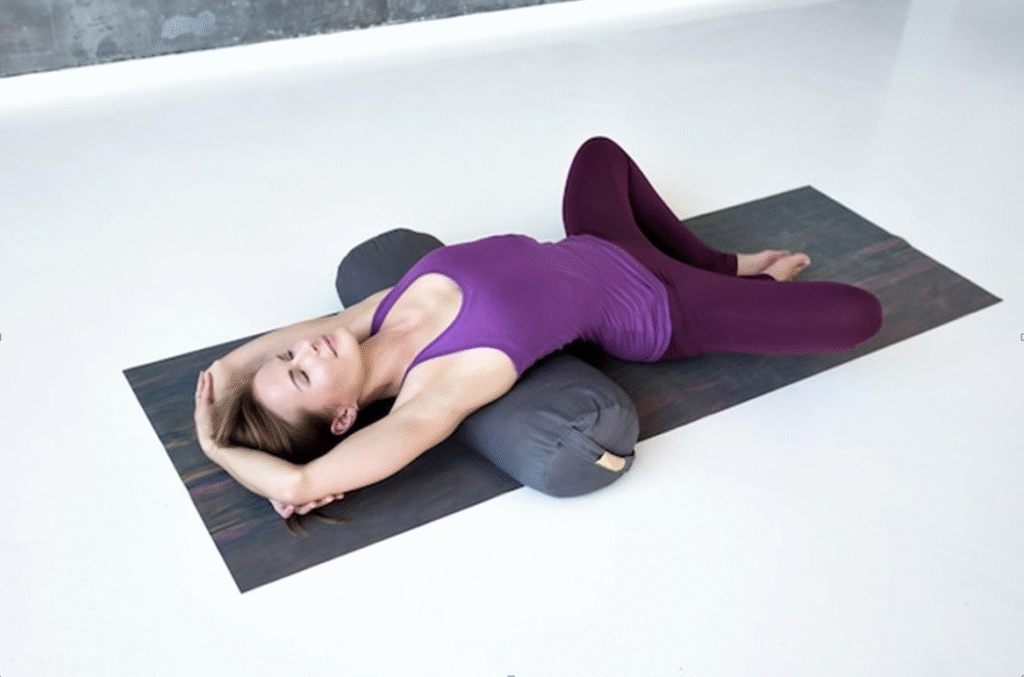
If you’ve ever rolled out a yoga mat hoping to shake off a heavy day, or taken a deep breath mid-pose thinking, “Wow, I really needed that,” then you’ve already experienced what science is finally catching up to: yoga works wonders for stress and anxiety relief. But how does it actually do that? Let’s dive into what’s really going on in your body and brain when you move, breathe, and flow your way to peace.
Why Yoga Feels Like a Reset Button
Ever notice how just stepping onto your mat makes you feel a little lighter, like you’re leaving the world behind for a while? That’s not in your head (well, it is, but not the way you think). When we practice yoga, we’re turning on what’s called the parasympathetic nervous system, aka the “rest and digest” mode. It’s the opposite of the “fight or flight” response, which is what kicks in when we’re stressed out.
Yoga, especially slow and mindful styles like Hatha, Yin, or Restorative yoga, helps calm that high-alert system and encourages your body to downshift. Your heart rate slows, your breathing deepens, and your muscles soften. This is exactly the kind of environment your body needs to recover from stress and anxiety.
The Cortisol Connection: How Yoga Impacts Your Stress Hormones
Cortisol is your body’s main stress hormone. It spikes when you’re running late, dealing with conflict, or scrolling through bad news at 2 AM. Chronic high levels of cortisol are bad news for your brain, your gut, your sleep, you name it. But here’s where yoga comes in like a hero: studies show that consistent yoga practice actually reduces cortisol levels.
Yep, doing yoga regularly can help you feel calmer, not just during the session but long after. A 2024 review published in the Journal of Psychosomatic Research found that participants who did yoga three times a week for 12 weeks had significantly lower cortisol levels than those who didn’t. That’s a pretty solid reason to keep practicing, even on the days when you’d rather just binge-watch something.
What’s Going On in Your Brain?
One of the coolest things about yoga is what it does to your brain. First off, it increases GABA (gamma-aminobutyric acid), which is a neurotransmitter that helps quiet the nervous system. Low GABA levels are linked with anxiety and mood disorders, so boosting GABA naturally through yoga is a big deal.
MRI studies have shown that people who practice yoga regularly have more gray matter in parts of the brain related to emotional regulation, decision-making, and memory. So not only are you getting more chill, but you’re also building a stronger, more resilient brain.
Another major brain boost? Yoga enhances activity in the prefrontal cortex, which is the part of the brain that helps you manage emotions, plan, and stay focused. That’s why after a good session, you might feel more clear-headed, less reactive, and better equipped to handle whatever comes next.
Yoga vs. Anxiety: Why It’s More Than Just Stretching
Let’s talk about anxiety for a second. It’s not just nervousness, it’s a full-body experience. Your chest tightens, your mind races, your breathing speeds up, and you might even feel physically sick. Yoga, with its emphasis on controlled breathing (pranayama) and present-moment awareness, helps short-circuit that entire stress response.
When you breathe slowly and deliberately, say, during a long exhale in a child’s pose, you send a message to your brain that says, “We’re safe. You can relax now.” Over time, these messages train your body to respond differently to anxiety triggers. You start creating space between stimulus and reaction. That’s powerful stuff.
And don’t forget the physical release. Our bodies hold stress in all kinds of weird places: tight hips, tense shoulders, clenched jaws. Yoga gives you the chance to physically release that tension. Ever finish a yoga class and realize your neck moves more freely or your breath comes easier? That’s not just stretching. That’s healing.
Why the Breath is Everything
If you only take one thing away from yoga for stress and anxiety relief, let it be this: your breath is the key. It’s the bridge between your mind and body. Fast, shallow breathing fuels anxiety, but slow, deep breaths can actually switch off the stress response.
One breathing technique that’s gotten a lot of attention in the last year is box breathing, inhaling for four counts, holding for four, exhaling for four, and holding again for four. It’s simple, but it works like magic. Pair that with gentle movement, and you’re basically telling your body, “We’re cool, no need to panic.”
Studies also show that alternate nostril breathing (nadi shodhana) balances the nervous system and lowers stress levels. It might feel strange at first, but once you get the hang of it, it’s a fantastic tool to use anywhere, anytime you feel anxiety creeping in.
The Mindfulness Factor
Another big reason yoga works for anxiety and stress relief is mindfulness. The whole practice is about paying attention, whether it’s noticing the sensations in your body, the rhythm of your breath, or the way your mind keeps wandering. And research shows that being present, even for a few moments, can drastically lower stress levels.
Mindfulness helps you step out of the worry loop. When you’re fully present in a pose, you’re not replaying that awkward conversation or fretting about tomorrow’s meeting. You’re just… here. And that presence trains your brain to focus on what’s real, not the what-ifs.
In fact, a 2023 study from Stanford found that people who practiced yoga-based mindfulness had lower levels of anxiety and were better at coping with uncertainty compared to those who didn’t. That’s something we could all use more of, especially in unpredictable times.
It’s Not About Being Flexible
One of the biggest myths that still floats around yoga is that you need to be flexible to do it. Nope. Yoga meets you exactly where you are. Whether you can touch your toes or not doesn’t matter. What matters is how you feel while you’re doing it and the intention you bring to the mat.
In fact, people who start yoga to deal with stress and anxiety often say that it’s not the physical poses but the mental clarity and emotional release that keep them coming back. The movement just gives your mind a reason to slow down.
You don’t need fancy gear either. You don’t need incense or a retreat in Bali. You just need a little space, a mat (or carpet, or towel), and the willingness to show up for yourself-even if it’s just for ten minutes.
Best Types of Yoga for Stress & Anxiety Relief
If you’re wondering where to start, some types of yoga are especially great for calming the nervous system. Here are a few:
- Restorative Yoga – This is like adult nap time, in the best way. You hold poses for several minutes using props like blankets and bolsters. Your body gets to fully relax, and your mind follows.
- Yin Yoga – Slow, deep stretches that target the connective tissues and encourages stillness. You hold poses for up to five minutes, which can be surprisingly intense (in a good way).
- Hatha Yoga – A slower-paced style that focuses on alignement and breath. Great for beginners and for reconnecting with your body.
- Yoga Nidra – Also known as yogic sleep, this is a guided meditation that brings you into a state between waking and sleeping. It’s incredibly restorative.
- Vinyasa Flow – If you need to move and sweat a little before you can relax, this one is for you. It links breath with movement and can help discharge excess energy that fuels anxiety.
You Don’t Need to Go All-In
Here’s a little secret: you don’t have to commit to an hour-long session every day to get the benefits. Just 10 to 20 minutes of yoga a few times a week can make a massive difference. The key is consistency. It’s kind of like planting seeds; you won’t see a tree right away, but keep watering it and eventually, something beautiful grows.
You can start small. Do a few sun salutations in the morning. Try a breathing technique before bed. Roll around on the floor with your eyes closed and just feel your body. That’s yoga, too. It doesn’t have to be perfect. It just has to be yours.
Community & Connection
Another underrated benefit of yoga? The sense of connection. Whether you go to a class or follow along with someone on YouTube, there’s something powerful about knowing other people are on the same journey. You’re not alone in feeling overwhelmed or anxious.
And sometimes, community is part of the healing. When you step into a studio or even join an online challenge, you start to feel supported. You see others showing up for themselves, and it reminds you to do the same.
Yoga + Lifestyle = Long-Term Change
Yoga is amazing, but it’s not a magic wand. The best results come when it’s part of a larger lifestyle that supports your mental health. That means eating nourishing food, getting good sleep, setting boundaries, and doing things that bring you joy like reading, gardening, or eating a big bowl of popped popcorn on a rainy day.
When you combine yoga with other positive habits, you start to build a strong foundation. You stop reacting to stress so intensely. You notice anxiety before it spirals. You start living from a calmer, more grounded place.
The 2025 Outlook: More Science, More Support
The good news? More and more doctors, therapists, and scientists are embracing yoga as a legit tool for managing stress and anxiety. In 2025, you’ll find yoga incorporated into mental health clinics, offered at workplaces, and recommended as part of treatment plans, not as an afterthought, but as a proven path to healing.
Apps like Calm, Insight Timer, and Down Dog are offering personalized yoga sessions that focus on emotional wellness. Therapists are combining yoga with cognitive behavioral therapy (CBT) to create even more effective outcomes. And schools are teaching kids how to breathe and move through big emotions. The future of yoga is here, and it’s only getting better.
If you’ve been curious about yoga or if you’ve fallen off the mat for a while, consider this your nudge to start (or start again). It’s not about doing the hardest poses or having the perfect form; it’s about taking care of your nervous system, showing up for yourself, and finding moments of peace in a chaotic world.
Stress and anxiety might not ever fully disappear, but with yoga, you’ll be better equipped to face them with steadier breath, a clearer mind, and a stronger heart. So go ahead, roll out your mat, take a deep breath, and start where you are. You’ve got this.
